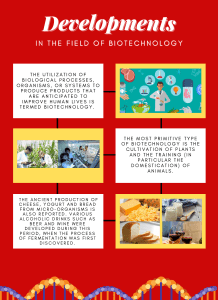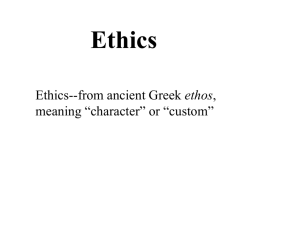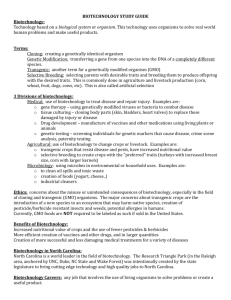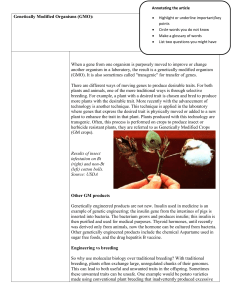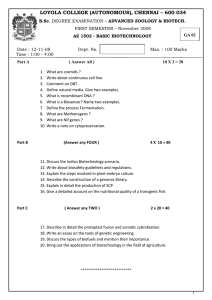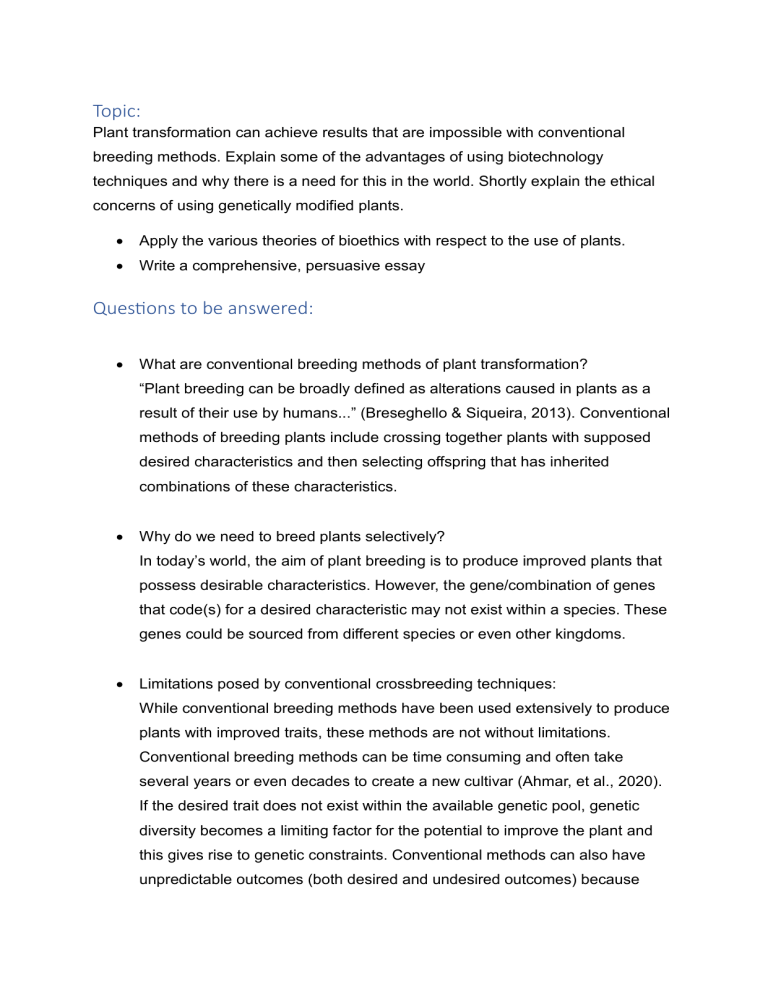
Topic: Plant transformation can achieve results that are impossible with conventional breeding methods. Explain some of the advantages of using biotechnology techniques and why there is a need for this in the world. Shortly explain the ethical concerns of using genetically modified plants. Apply the various theories of bioethics with respect to the use of plants. Write a comprehensive, persuasive essay Questions to be answered: What are conventional breeding methods of plant transformation? “Plant breeding can be broadly defined as alterations caused in plants as a result of their use by humans...” (Breseghello & Siqueira, 2013). Conventional methods of breeding plants include crossing together plants with supposed desired characteristics and then selecting offspring that has inherited combinations of these characteristics. Why do we need to breed plants selectively? In today’s world, the aim of plant breeding is to produce improved plants that possess desirable characteristics. However, the gene/combination of genes that code(s) for a desired characteristic may not exist within a species. These genes could be sourced from different species or even other kingdoms. Limitations posed by conventional crossbreeding techniques: While conventional breeding methods have been used extensively to produce plants with improved traits, these methods are not without limitations. Conventional breeding methods can be time consuming and often take several years or even decades to create a new cultivar (Ahmar, et al., 2020). If the desired trait does not exist within the available genetic pool, genetic diversity becomes a limiting factor for the potential to improve the plant and this gives rise to genetic constraints. Conventional methods can also have unpredictable outcomes (both desired and undesired outcomes) because genetic interactions can lead to numerous unexpected combinations of traits. Because of this, it becomes increasingly difficult to achieve the desired phenotypic outcome. Certain traits in plants can be complex to achieve. Often involving the alteration of multiple genes, conventional methods of breeding may not address the processes required to achieve such traits. Conventional methods of breeding can also be labour and resource intensive with skilled labour requirements alongside the need for large land. Lastly, conventional methods of breeding may not be agile enough to become feasible solutions to rapidly emerging challenges. What is biotechnology? According to (Vedantu, 2016), biotechnology is best defined as the use of scientific techniques to improve and alter plants, animals and microorganisms’ value based on DNA and its concepts. It involves the exploitation of biological processes especially the manipulation of organisms’ genetic material. Advantages of using biotechnology? Techniques from biotechnology have not only increased the efficiency of, but also quickened the process of selective breeding. The use of biotechnology tools has facilitated the transfer of genes between species, and this has led to significant advancements in plants’ resistance to pests and diseases as well as improving crop yield and quality. Biotechnology has led to the discovery and development of traits such as herbicide tolerance, disease resistance and enhanced nutritional content. This poses several economic benefits for farmers and has greatly reduced our environmental impact. Through various biotechnological methods such as tissue culture and cryopreservation, endangered plant species can be conserved, preserving genetic diversity. Why is there a need for biotechnology? Climatic extremes such as global warming and high population growth cause a wide range of negative effects on plants, their production, quality, and quantity. These effects significantly increase the world’s demand for food. Left to deal with the problem of providing more food for a larger population on less land, biotechnology is tasked with a vital role. It aims at “fulfilling the goal of attaining food security for the present and future generations” (Munaweera, et al., 2022). The development of biotechnological techniques makes room for more precise and faster genetic modifications of plants. Biotechnology also supports sustainable agricultural productivity to meet food demands as an adaptation to climate change. “Arguably, the use of biotechnology in agriculture is deemed to be more effective than that of agrochemicals” (Vedantu, 2016). The use of biotechnological techniques equips farmers with tools to manage the costs of productions, making the production of crops cheaper. Biotechnology can be used to address “situations that combine multiple needs” (Ahmar, et al., 2020). For example, in golden rice, a single crop was required to provide both sustainable food and added nutritional benefits. We can say the golden rice was ‘transformed’, but what is plant transformation? What is plant transformation? For many years, we have used traditional methods of modifying crops to suit our needs. These methods include crossbreeding, selective breeding, and mutation breeding. However, according to the U.S (FDA, 2023), the emergence and development of biotechnology has allowed us to use genetic engineering to transfer foreign genetic material into plants for desired outcomes such as higher crop yields, longer storage life, better appearance and nutrition, less crop loss and even combinations of these traits. Plant transformation makes use of techniques that directly manipulate the plant genome. Plant transgenesis is the direct transfer of foreign genes to a plant to confer specific traits or characteristics, creating a transgenic plant in the process. As mentioned before, these genes could come from a different species or even an entirely different kingdom such as bacterium. Plant transformation has the potential to achieve results that are nearly impossible with conventional methods of breeding. Some methods used in plant transgenesis include agrobacterium-mediated transformation, biolistic (gene gun) transformation, electroporation, microinjection, protoplast transformation and virus-mediated transformation to transfer desired genes into plants. Another method used to control the expression of the desired trait is antisense technology. Antisense technology is an approach that allows the manipulation of gene expression. Antisense technology has several applications and benefits including gene silencing and trait modification. Discuss and explain the ethical concerns of using genetically modified plants? While biotechnology can be the solution addressing much of the world’s agricultural challenges, the release of genetically modified plants into the natural environment warrants careful consideration. Genetically modified plants have raised a range of health, societal and environmental concerns. The release of genetically modified plants has raised health concerns such as allergenicity and toxicity in which the introduction of foreign genes in crops might lead to the unintended production of toxic compounds that pose a risk to human health. According to (Raman, 2023), genetically modified plants could potentially transfer genetically modified genes to wild, non-target crops. This raises concerns regarding the preservation of the integrity of our native ecosystems and species. While enhanced fitness and competitive traits are a desired outcome, they could lead to invasiveness in genetically modified plants which can eventually outcompete native species affecting the natural ecological balance (William, et al., 2014). This potential harm to non-GM crops, biodiversity and ecosystems raises ecological considerations. Over time, pests and weeds can grow resistance to the modified traits in plants and this could lead to increased chemical usage, damaging the environment. A serious ethical concern arises when patents on genes restrict access to plant genetic resources. According to (Gaharwar, et al., 2021)This poses an ethical risk imposed on farmers in developing countries regarding their exploitation. A lot of ethical concerns exist around the potential health effects of genetically modified plants as their long-term effects on human health are debated. It is argued that some important decisions regarding the implementation of genetically modified crops are not regulated ethically. This raises ethical concerns about public engagement and transparency as some regulatory decisions are motivated by corporate and political interests. To critically analyse the ethical concerns related to biotechnology and the emergence of genetically modified plants, the Hastings ethical framework, based on four ethical principles, can be used. One principle outlined in the framework is autonomy. According to the Merriam Webster dictionary, autonomy is “the quality or state of being self-governing.” Consumers autonomy is violated when they unknowingly consume genetically modified crops due to a lack on informed consent. A second principle outlined in the Hastings ethical framework is beneficence. This basically describes a state of doing and/or producing good. Beneficence highlights the environmental benefits of releasing genetically modified plants versus the potential risks they may impose on non-target species and ecosystems. The Hastings ethical framework also describes non-maleficence as an ethical principle associated with genetically modified plants. Under this principle which requires physicians not to cause harm, genetically modified plants can have potential unintended ecological consequences. Lastly, the socio-economic disparities motivated by GM plants are outlined by the ethical principle of justice. Justice, in simple terms refers to individuals getting what they deserve. The development of GM crops does not ensure equal access to the benefits of their genetic alterations as, according to some companies can patent their discoveries. What does the future of plant-based biotechnology products look like? Map plan: 1. 2. 3. 4. Discuss conventional methods of breeding plants (in a more negative light). Introduce Biotechnology and present the opportunities it offers. Contrast plant transformation to conventional methods of breeding plants Discuss ethical concerns relating to the genetic modification of plants Bibliography Ahmar, S. et al., 2020. PubMed Central. [Online] Available at: https://www.ncbi.nlm.nih.gov/pmc/articles/PMC7177917/ Anon., 2015. Interpersonal Needs. In: Business Communication for Success. s.l.:University of Minnesota Libraries Publishing. Breseghello, F. & Siqueira, G. C., 2013. Traditional and Modern Plant Breeding Methods with Examples in Rice (Oryza sativa L.). Journal of Agricultural and food chemistry. FDA, 2023. Agricultural Biotechnology. [Online] Available at: https://www.fda.gov/food/consumers/agricultural-biotechnology [Accessed 09 September 2023]. Gaharwar, S. U., Verma, A., Singh, R. & Tulika, P., 2021. Health Risks and Environmental Concerns of GM Crop Adoption. Policy Issues in Geneticall Modified crops. Munaweera, T. K., Jayawardana, N. U., Rajarathnam , R. & Dissanayake, N., 2022. Modern plant biotechnology as a strategy in addressing climate change and attaining food security. Agriculture & Food security. Raman, R., 2023. GMOs: Pros and Cons, Backed by Evidence. Healthline. Vedantu, 2016. Vedantu. [Online] Available at: https://www.vedantu.com/biology/biotechnology-in-agriculture William, J., Palladino, A. & Michael, T., 2014. Introduction to Biotechnology. 3 ed. s.l.:Pearson Education Limited. 5.
